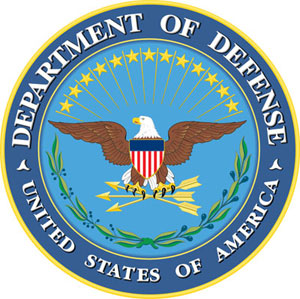I. The Military Bases
Military bases are conceived for training purposes, preparation and stockage
of military equipment, used by national armies throughout the World. They
are not very well known in view of the fact that they are not open to the
public at large.
Even though they take on different shapes, according to the
military function for which they were established; they can broadly be
classified under four main categories :
-
Air Force Bases (see photos 1 and 2)
-
Army or Land Bases
-
Navy Bases
-
Communication and Spy Bases
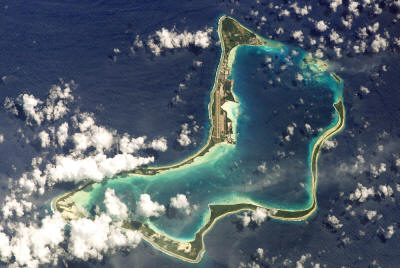
Photo 1
Air Base of Diego Garcia located in the Indian Ocean
Image:Diego Garcia (satellite).jpg
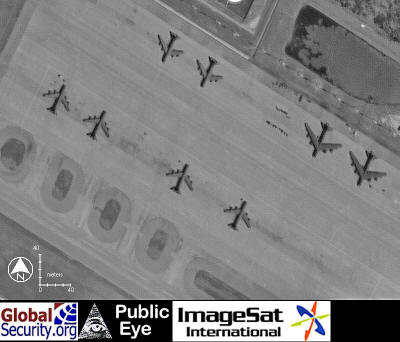
Photo 2
Diego Garcia.
An Aerial View of two B-52 and six Kc-a135
II.
More than 1000 U.S. Bases and/or Military Installations
The main sources of information on these military installations (e.g. C.
Johnson, the NATO Watch Committee, the International Network for the
Abolition of Foreign Military Bases) reveal that the U.S. operates and/or
controls between 700 and 800 military bases Worldwide.
In this regard,
Hugh d’Andrade and Bob Wing's 2002 Map 1 entitled "U.S.
Military Troops and Bases around the World, The Cost of 'Permanent War'",
confirms the presence of U.S. military personnel in 156 countries.
The
U.S. Military has bases in 63 countries. Brand new military bases have
been built since September 11, 2001 in seven countries.
In total, there are 255,065
U.S. military personnel deployed Worldwide.
These facilities include a total of 845,441 different buildings and
equipments. The underlying land surface is of the order of 30 million acres.
According to Gelman, who examined 2005 official Pentagon data, the U.S. is
thought to own a total of 737 bases in foreign lands.
Adding to the bases
inside U.S. territory, the total land area occupied by U.S. military bases
domestically within the U.S. and internationally is of the order of 2,202,735
hectares, which makes the Pentagon one of the largest landowners worldwide (Gelman,
J., 2007).
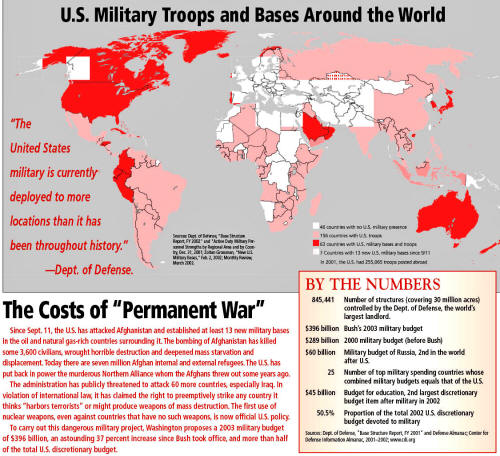
Map 1
U.S. Military Troops and Bases around the World.
The Cost of
«Permanent War» and Some Comparative Data
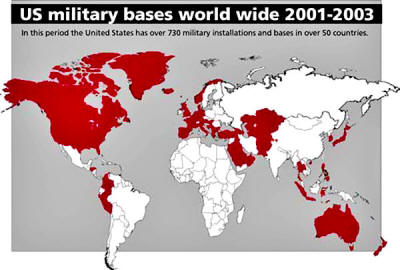
Map 2
The American Military Bases Around the World (2001-2003)
Source : http://www.nobases.org
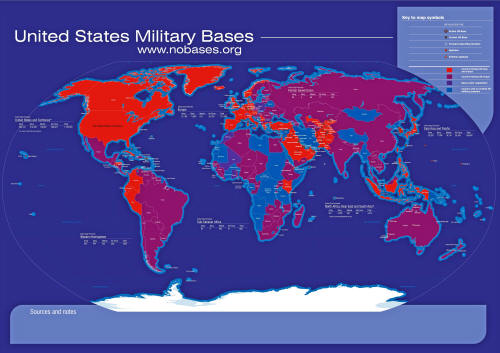
Map 3
U.S. Military Bases
The Map of the World Network "No Bases" (Map 3) reveals the following:
Based on a selective examination of military bases in North America, Latin
America, Western Europe, the Middle East, Central Asia, Indonesia, the
Philippines and Japan, several of these military bases are being used for
intelligence purposes. New selected sites are Spy Bases and
Satellite-related Spy Bases.
The Surface of the Earth is Structured as a Wide Battlefield
These military bases and installations of various kinds are distributed
according to a Command structure divided up into five spatial units and four
unified Combatant Commands (Map 4).
Each unit is under the Command of a
General.
The Earth surface is being conceived as a wide battlefield which can be
patrolled or steadfastly supervised from the Bases.
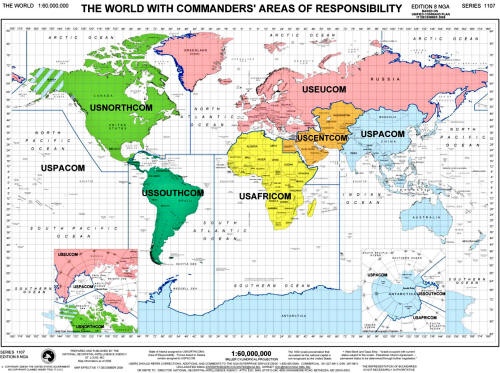
Map 4
The World and Territories Under the Responsibility of a Combatant
Command or Under a Command Structure
Map-the World With Commander' Area of Responsibility
Territories under a Command are:
-
the Northern Command (NORTHCOM) (Peterson
Air Force Base, Colorado)
-
the Pacific Command (Honolulu, Hawaii)
-
the
Southern Command (Miami, Florida - Map 5)
-
the Central Command (CENTCOM)
(MacDill Air Force Base, Florida)
-
the European Command
(Stuttgart-Vaihingen, Germany)
-
the Joint Forces Command (Norfolk,
Virginia)
-
the Special Operations Command (MacDill Air Force Base, Florida)
-
the Transportation Command (Scott Air Force Base, Illinois)
-
the
Strategic Command (STRATCOM) (Offutt Air Force Base, Nebraska)
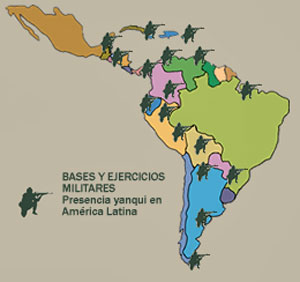
Map 5
The Southern Command
NATO Military Bases
The Atlantic Alliance (NATO) has its own Network of military bases, thirty
in total.
The latter are primarily located in Western Europe:
-
Whiteman, U.S.A., Fairford
-
Lakenheath and Mildenhall in United
Kingdom
-
Eindhoven in Netherlands
-
Brüggen, Geilenkirchen, Landsberg, Ramstein, Spangdahlem, Rhein-Main
in Germany
-
Istres and Avord in France
-
Morón de la Frontera and Rota in
Spain
-
Brescia, Vicenza, Piacenza, Aviano, Istrana, Trapani, Ancora, Pratica di
Mare, Amendola, Sigonella, Gioia dell Colle, Grazzanise and Brindisi in
Italy
-
Tirana in Albania
-
Incirlik in Turkey
-
Eskan Village in Soudi Arabia
-
Ali al Salem in Koweit
(http://www.terra.es/actualidad/articulo/html/act52501.htm)
III. The Global Deployment of
U.S. Military Personnel
There are 6000 military bases and/or military warehouses located in the
U.S. (See Wikipedia, February 2007).
Total Military Personnel is of the order of 1,4 million of which 1,168,195
are in the U.S. and U.S. overseas territories.
Taking figures from the same source, there are 325,000
U.S. military personnel
in foreign countries:
-
800 in Africa
-
97,000 in Asia (excluding the Middle
East and Central Asia)
-
40,258 in South Korea
-
40,045 in Japan
-
491 at the Diego Garcia Base in the
Indian Ocean
-
100 in the Philippines, 196 in
Singapore
-
113 in Thailand
-
200 in Australia
-
16,601 Afloat
In Europe, there are 116,000 U.S. military personnel including 75,603 who are
stationed in Germany.
In Central Asia about 1,000 are stationed at the Ganci (Manas) Air Base in
Kyrgyzstan and 38 are located at Kritsanisi, in Georgia, with a mission to
train Georgian soldiers.
In the Middle East (excluding the Iraq war theater) there are 6,000
U.S.
military personnel, 3,432 of whom are in Qatar and 1,496 in Bahrain.
In the Western Hemisphere, excluding the U.S. and
U.S. territories, there are
700 military personnel in Guantanamo, 413 in Honduras and 147 in Canada.
Map 3 provides information regarding military personnel on duty, based on a
regional categorization (broad regions of the world). The total number of
military personnel at home in the U.S. and/or in U.S. Territories is
1,139,034.
There are 1,825 in Europe 114, 660, 682 in
Sub-Saharan Africa, 4,
274 in the Middle East and Southern Asia, 143 in the Ex-USSR, and 89,846 in
the Pacific.
IV. The Operational Cost of the Worldwide Military Network
U.S. defense spending (excluding the costs of the Iraq war) have increased
from 404 in 2001 to 626 billion dollars in 2007 according to data from the
Washington based Center for Arms Control and Non-Proliferation.
U.S. defense
spending is expected to reach 640 billion dollars in 2008.
(Figure 1 and http://www.armscontrolcenter.org/archives/002244.php).
These 2006 expenses correspond to 3.7% of the U.S. GDP and $935.64 per capita
(http://en.wikipedia.org/wiki/Military_of-the_United_States).
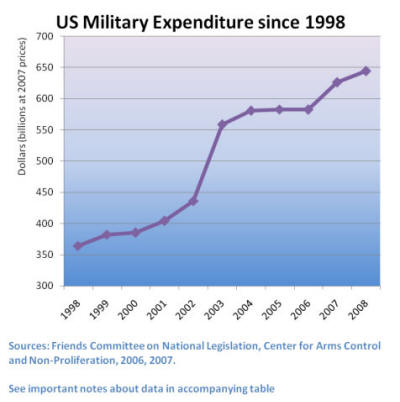
Figure 1
U.S. Military Expenditures since 1998
At 2007 prices, 1998 military spending was $364.35bn. 2008’s is
approximately $643.9bn
According to Fig 1, the 396 billion dollars military budget proposed in 2003
has in fact reached 417.4 billion dollars, a 73% increase compared to 2000
(289 billion dollars). This outlay for 2003 was more than half of the total
of the U.S. discretionary budget.
Since 2003, these military expenditures have to be added to those of the
Iraq war and occupation The latter reached in March 2007, according to the
National Priorities Project, a cumulative total of 413 billion dollars.
(http://www.janes.com/defence/news/jdi/jdi050504_1_n.shtml, http://nationalpriorities.org/index.php?option=com_wrapper&Itemid=182).
Estimates of the Defense Department budget needs, made public in 2006 in the
DoD Green Book for FY 2007 are of the order of 440 billion dollars.
(http://www.dod.mil/comptroller/defbudget/fy2007/index.html)
Military and other staff required numbered 1,332,300. But those figures do
not include the money required for the "Global World on Terrorism" (GWOT).
In other words, these figures largely pertain to the regular Defense budget.
A Goldstein of the Washington Post, within the framework of an article on
the aspects of the National 2007 budget titled «2007 Budget Favors Defense»,
wrote about this topic:
"Overall, the budget for the 2007 fiscal year would further reshape the
government in the way the administration has been striving to during the
past half-decade: building up military capacity and defenses against
terrorist threats on U.S. soil, while restraining expenditures for many
domestic areas, from education programs to train service"
(http://www.washingtonpost.com/wp-dyn/content/article/2006/02/04/AR2006020401179.html)
V. U.S. Military Bases to Protect Strategic Energy Resources
In the wake of 9/11, Washington initiated its "Global War on Terrorism"
(GWOT), first in Afghanistan and then in Iraq.
Other countries, which were
not faithfully obeying Washington's directives including Iran, North Korea,
Syria and Venezuela have been earmarked for possible U.S. military
intervention.
Washington keeps a close eye on countries opposed to
U.S.
corporate control over their resources. Washington also targets
countries where there are popular resistance movements directed against
U.S. interests, particularly in South America.
In this context, President Bush made a quick
tour to Brazil, Uruguay, Colombia, Guatemala and Mexico «to promote
democracy and trade» but also with a view to ultimately curbing and
restraining popular dissent to the U.S. interests in the region.
(http://www.voanews.com/spanish/2007-03-08-voa1.cfm)
The same
broad approach is being applied in Central Asia.
According to Iraklis Tsavdaridis, Secretary of the World Peace Council (WPC):
"The establishment of U.S. military bases should not of course be seen
simply in terms of direct military ends. They are always used to promote the
economic and political objectives of U.S. capitalism.
For example, U.S.
corporations and the U.S. government have been eager for some time to build
a secure corridor for U.S..-controlled oil and natural gas pipelines from the
Caspian Sea in Central Asia through Afghanistan and Pakistan to the Arabian
Sea.
This region -has more than 6 percent of the world's proven oil reserves
and almost 40 percent of its gas reserves. The war in Afghanistan and the
creation of U.S. military Bases in Central Asia are viewed as a key
opportunity to make such pipelines a reality."
(http://stopusa.be/campaigns/texte.php?section=FABN&langue=3&id=24157).
The U.S.. are at War in Afghanistan and Iraq. They pursue these military
operations until they reach their objective which they call "VICTORY".
According to
Wikipedia, American
troops fighting in these countries number 190,000.
The "Enduring Freedom"
Operation in Iraq alone has almost 200,000 military personnel, including
26,000 from other countries participating to the U.S. sponsored "Mission".
About 20,000 more could join other contingents in the next few months.
In
Afghanistan, a total of 25,000 soldiers participate to the operation (Map 6
and Map 7).
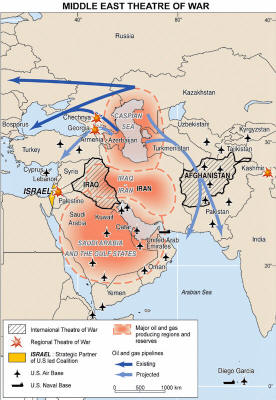
Map 6
Petroleum and International Theatre of War in the Middle East and
Central Asia
Source : Eric Waddell, The Battle for Oil, Global Research, 2003
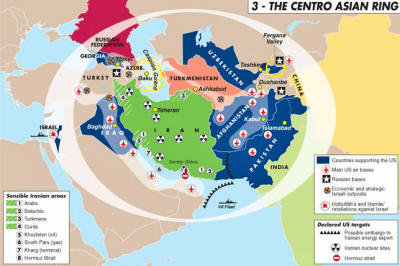
Map 7
American Bases Located in Central Asia
The Centro Asia Ring
VI. Military Bases Used for the Control of Strategic Renewable Resources
U.S. Military Bases in foreign countries, are mainly located in Western
Europe:
There are nine military installations in Japan (Wikepedia).
In the last few years, in the context of the GWOT, the
U.S. has built 14 new
bases in and around the Persian Gulf.
It is also involved in construction and/or or reinforcement of 20 bases (106
structured units as a whole) in Iraq, with costs of the order of 1.1 billion
dollars in that country alone (Varea, 2007) and the use of about ten bases
in Central Asia.
The U.S. has also undertaken continued negotiations with several countries to
install, buy, enlarge or rent an additional number of military bases.
The
latter pertain inter alia to installations in Morocco, Algeria, Mali, Ghana,
Brazil and Australia (See Nicholson, B., 2007), Poland, Czech Republic
(Traynor, I., 2007), Ouzbekistan, Tadjikistan, Kirghizstan, Italy (Jucca,
L., 2007) and France.
Washington has signed an agreement to build a military base in Djibouti
(Manfredi, E., 2007). All these initiatives are a part of an overall plan to
install a series of military bases geographically located in a West-East
corridor extending from Colombia in South America, to North Africa, the Near
East, Central Asia and as far as the Philippines (Johnson, C., 2004).
The U.S.
bases in South American are related to the control and access to the
extensive natural biological, mineral and water resources resources of the
Amazon Basin. (Delgado Jara, D., 2006 and Maps 9 and 10).
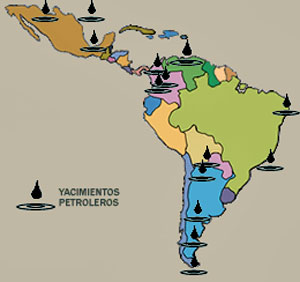
Map 8
Oil Fields in Latin America
Source :
http://web.archive.org/web/20040619050211/http://www.visionesalternativas.com/militarizacion/mapas/mapahegem.htm
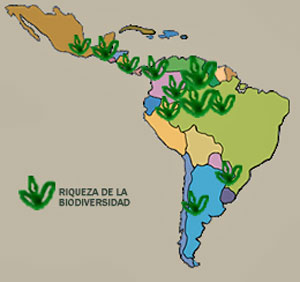
Map 9
The Biological Wealth of Latin America
Source: http://web.archive.org/web/20040619050211/http://www.visionesalternativas.com/militarizacion/mapas/mapahegem.htm
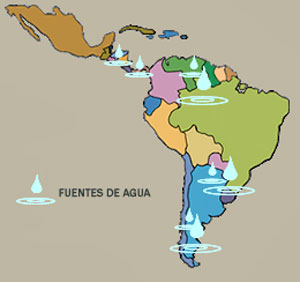
Map 10
Freshwater Resources in Latin America
Source :
http://web.archive.org/web/20040619050211/http://www.visionesalternativas.com/militarizacion/mapas/mapahegem.htm
VII. Resistance Movements
The network of U.S. military bases is strategic, located in
proximity of
traditional strategic resources including nonrenewable sources of energy.
This military presence has brought about political opposition and resistance
from progressive movements and antiwar activists.
Demonstrations directed against
U.S. military presence has developed in Spain,
Ecuador, Italy, Paraguay, Uzbekistan, Bulgaria and in many other countries.
Moreover, other long-termer resistance movements directed against U.S.
military presence have continued in South Korea, Puerto Rico, Guam, the
Philippines, Cuba, Europe, Japan and other locations.
The Worldwide resistance to
U.S. foreign military bases has grown during the
last few years. We are dealing with an International Network for the
Abolition of U.S. Military Bases.
Such networks' objective is to broadly pursue disarmament, demilitarization
processes Worldwide as well as dismantle U.S. military bases in foreign
countries.
The NO BASES Network organizes educational campaigns to sensitize public
opinion. It also works to rehabilitate abandoned military sites, as in the
case of Western Europe.
These campaigns, until 2004, had a local and national impact.
The network is now in a position to reach people Worldwide.
The network
itself underscores that "much can be gained from greater and deeper linkages
among local and national campaigns and movements across the globe. Local
groups around the world can learn and benefit from sharing information,
experiences, and strategies with each other"
(http://www.no-bases.org/index.php?mod=network&bloque=1&idioma=en)
"The realization that one is not alone in the struggle against foreign bases
is profoundly empowering and motivating. Globally coordinated actions and
campaigns can highlight the reach and scale of the resistance to foreign
military presence around the world.
With the trend of rising miniaturization
and resort to the use of force around the world, there is now an urgent and
compelling need to establish and strengthen an international network of
campaigners, organizations, and movements working with a special and
strategic focus on foreign military presence and ultimately, working towards
a lasting and just system of peace»
(http://www.no-bases.org/index.php?mod=network&bloque=1&idioma=en
)
The Afghanistan and Iraq wars have, in this regard, created a
favorable
momentum, which has contributed to the reinforcement of the movement to
close down U.S. military bases in foreign countries:
"At the time of an International anti-war meeting held in Jakarta in May
2003, a few weeks after the start of the Iraq invasion, a global
anti-military Bases campaign has been proposed as an action to priorize
among global anti-war, justice and solidarity movements"
(http://www.no-bases.org/index.php?mod=network&bloque=1&idioma=en).
Since then, the campaign has acquired greater recognition.
E-mail lists have
been compiled (nousbases@lists.riseup.net and
nousbases-info@lists.riseup.net) that permit the diffusion of the movement
members experiences and information and discussion exchanges. That list now
groups 300 people and organizations from 48 countries.
A Web site permits
also to adequately inform all Network members. Many rubrics provide highly
valuable information on ongoing activities around the World.
http://www.no-bases.org/index.php?mod=network&bloque=1&idioma=en
In addition, the Network is more and more active and participates in
different activities. At the World Social Forums it organized various
conferences and colloquia. It was present at the European Social Forum held
in Paris in 2003 and in London in 2004 as well as at the the America’s
Social Forum in Ecuador in 2004, and at the Mediterranean Social Forum in
Spain in 2005.
One of the major gatherings, which was held in Mumbai, India, in 2004, was
within the framework of the World Social Forum. More than 125 participants
from 34 countries defined the foundations of a coordinated global campaign.
Action priorities were identified, such as the determination of a global day
of action aiming at underscoring major issues stemming from the existence of
U.S. military bases. The Network also held four discussion sessions at the
Porto Alegre Social Forum in 2005. One of those pertained to the financing
of the Network's activities.
It is important to recall that the Network belongs to the Global Peace
Movement.
Justice and Peace organizations have become more sensitized on
what was at stake regarding U.S. military bases.
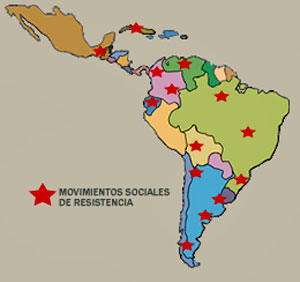
Map 11
Social and Resistence Movements in Latin America
Source : http://web.archive.org/web/20040619050211/http://www.visionesalternativas.com/militarizacion/mapas/mapahegem.htm
The Quito and Manta International Conference
Ecuador, March 2007
A Network World Conference for the Abolition of Foreign Military Bases was
held at Quito and at Manta, Ecuador, from March 5 to 9, 2007. (click
here,
here and
here)
The objective of the Conference was to underscore the political, social,
environmental and economic impacts of U.S. military bases, to make known the
principles of the various Anti-Bases movements and to formally build the
Network, its strategies, structure and Action Plans.
The main objectives of
the Conference were the following:
-
Analyze the role of Foreign Military
Bases and other features of military presence associated to the
global dominance strategy and their impacts upon population and
environment
-
Share experiences and reinforce the
built solidarity resulting from the resistance battles against
Foreign military Bases around the World
-
Reach a consensus on objectives
mechanisms, on action plans, on coordination, on communication
and on decision making of a Global Network for the abolition of
all Foreign military Bases and of all other expressions of
military presence
-
Establish global action plans to fight and reinforce the resistance of
local people and ensure that these actions are being coordinated at the
international level.
COMITÉ DE SURVEILLANCE OTAN. 2005. Las bases militares : un aspecto de la
estrategia global de la OTAN. Intervencion del Comité Surveillance Otan en
la Conferencia Internacional realizada en La Habana 7-11.11.2005. 9 pages.
DELGADO JARA, Diego. 2006. Bases de Manta, Plan Colombia y dominio de la
Amazonia. Militarizacion de la Hegemonia de EE. UU. En América latina. 17
pages.
EQUIPO DE COMUNICACIÓN CONFERENCIA NO BASES. 2007. La gente del mundo no
quiere bases militares extranjeras.
GELMAN, J. 2007. Terratenientes. Rebelion. 26 de Febrero de 2007,
http://www.rebelion.org/noticia.php?id-47353
Ghana to host U.S. Military Base? February 26, 2006.
JOHNSON, C., America's Empire of Bases. January 2004.
JOHNSON, C. America’s Empire of Bases. Janvier 2004 .
JOHNSON, C. 2005. The Sorrows of Empire. Militarism, Secrecy, and the End of
the Republic. Henry Holt, April 2005, Paperback. 389 pages.
JOHNSON, C., 2007.. 737 U.S. Military Bases = Global Empire. February 19,
2007
JUCCA, L., 2007. Italians protest over U.S. base expansion. Sat Feb 17,
2007.
MANFREDI, E. 2007. Djibouti : Hôtel Corne d’Afrique, grande base américaine.
Le GRAND SOIR.info. Édition du 23 mars 2007.
NEW INTERNATIONALIST. 2004. The Bases of Resistance, December 2004, Issue
374.
NICHOLSON, B. 2007. Secret New Us Spy base to Get Green Light. February 15,
2 007.
TRAYNOR, I. 2007. U.S. EXPANDS, Builds New Military Bases in Europe. The
Guardian, anuary 22, 2007.
TSAVDARIDIS, I., 2005. Military Bases around the world and in Europe – the
role of the USA and NATO. Novembre 2005. Stop USA / STOP United States of
Agression.
VAREA, C., Las bases Militares de EEUU en Iraq. 4 mai 2006. Nodo50.
Web Sites
An Internet Guide to United States Military Bases Around the World: http://www.libsci.sc.edu/bob/class/clis734/webguides/milbase.htm
APPEL A UN RASSEMBLEMENT INTERNATIONAL en Mars 2007, Équateur, Pour
l’abolition de toutes les bases militaires
Bases y Ejercicios Militares de EE.UU. El Comando Sur.
BUILDING A GLOBAL ANTI-MILITARY BASES MOVEMENT
Campana. Un mundo sin bases militares . Asemblea de Organizaciones y
Movimientos contra la guerra, la OTAN y el Neoliberalismo (Madrid), Nodo50.
Challenges to the U.S. Empire,
http://www.globalpolicy.org/empire/challenges/challengesindex.htm.
Washington veut installer une base militaire en Algérie. Le Quotidien
d'Oran, 20 juillet 2003.
Empire? http://www.globalpolicy.org/empire/index.htm
International Conference against Foreign Military Bases. Final Declaration.
[Fsmed-general] for all that are against foreign military bases: http://www.grups.pangea.org/pipermail/fsmed-general/Week-of-Mon-20060206/001002.html
FUENTES DE AGUA EN AMERICA LATINA
http://www.visionesalternativas.com/militarizacion/mapas/mapahegem.htm
Abdulhafeth Khrisat, Impérialisme américain et politique militaire, ,
Université Mu’tah
Interview with Chalmers Johnson, Part 1. An Empire of More Than 725 Military
Bases.
Liste des bases militaires américaines dans le monde.
Major Military Bases World-Wide,
http://www.globalsecurity.org/military/facility/sites.htm
Military Bases Around The World, http://www.fsmitha.com/com/bases.htm
Military Bases around the world and in Europe - the role of the USA and NATO
, Iraklis Tsavdaridis, Secretary of the World Peace Council (WPC) 8th
November 2005, From the Greek Committee for International Detente and Peace
(EEDYE), Presented on November 8, 2005 at the International Conference on
Foreign Military Bases in Havana/Cuba organized by MOVPAZ :
http://stopusa.be/campaigns/texte.php?section=FABN&langue=3&id=24157
Military of the United States :
http://en.wikipedia.org/wiki/United_States_armed_forces
MOVIMIENTOS SOCIALES DE RESISTENCIA EN AMÉRICA LATINA
No a la instalacion de una base de la OTAN en Zaragoza : http://www.ecologistasenaccion.org/article.php3?id_article=6261
OTAN – Le grand jeu des bases militaires en terre européenne : http://www.mondialisation.ca/index.php?context=viewArticle&code=DIN20060509&articleId=2414
Protestas contra bases militares de EEUU en Espana : http://spanish.peopledaily.com.cn/spanish/200104/02/sp20010402_46341.html
RIQUEZA DE LA BIODIVERSIDAD EN AMÉRICA LATINA
U.S. Military Troops and Bases Around the World : http://www.globalpolicy.org/empire/intervention/2003/0710imperialmap.htm
U.S. Military Troops and Bases Around the World /united for peace & justice: http://www.unitedforpeace.org/article.php?id=884
U.S. Military Expansion and Intervention : http://www.globalpolicy.org/empire/intervention/index.htm
YACIMIENTOS PETROLEROS EN AMÉRICA LATINA : http://www.visionesalternativas.com/militarizacion/mapas/mapapetrol.htm

